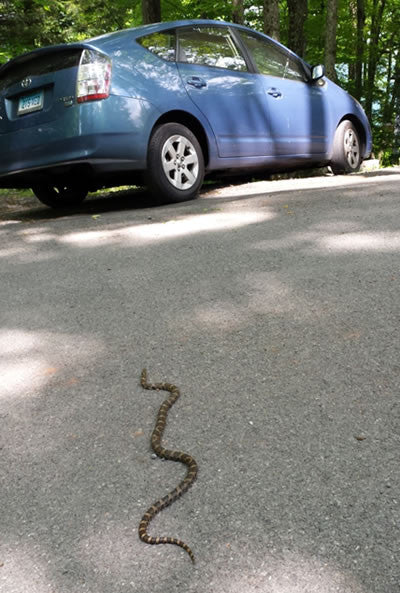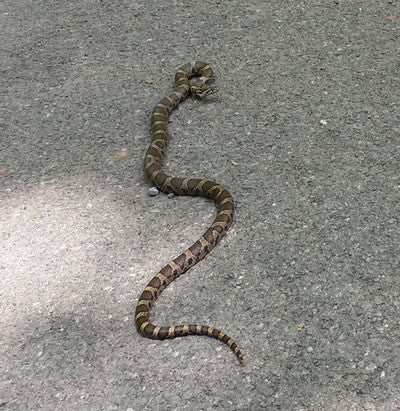Snakes, Stress and Brain Science
I'm in the Catskills in upstate NY this week and I snapped this picture of a snake that looked like it was about to eat my car. There's a lot of wildlife up here, and one of the things I love most about living in the woods is seeing creatures like this and trying to figure out exactly what it is I've seen by looking them up online. Once I got on the internet, I discovered that this four foot long snake was a harmless milk snake. I also watched a great video of a baby milk snake attacking a man who was brave enough to pick it up. Even though it's just a baby, you can see in this video that this snake's brain is programmed to attack.
 The fascinating thing about evolution is that we all have this "reptilian" part of our brain that wants to attack, no matter what the circumstances. Fortunately for us, we have other parts of our brain (like the prefrontal cortex) that are layered on top of the reptilian brain, that keep us from doing crazy things like telling our bosses to take this job and shove it (even though on some level we may really want to say this). Brain scientists describe these opposing parts of the brain as being somewhat like an iPod mounted on top of an eight track tape player. The new technology evolved right over the old. And to some extent, a great deal of the stress we experience is the result of these separate parts of the brain not working in tandem.
The fascinating thing about evolution is that we all have this "reptilian" part of our brain that wants to attack, no matter what the circumstances. Fortunately for us, we have other parts of our brain (like the prefrontal cortex) that are layered on top of the reptilian brain, that keep us from doing crazy things like telling our bosses to take this job and shove it (even though on some level we may really want to say this). Brain scientists describe these opposing parts of the brain as being somewhat like an iPod mounted on top of an eight track tape player. The new technology evolved right over the old. And to some extent, a great deal of the stress we experience is the result of these separate parts of the brain not working in tandem.
Let me give you an example of what I mean: Have you ever been so startled by a loud noise (like a car back-firing or something crashing down behind you or even someone sneaking up on you and surprising you) that you practically jumped right out of your skin? Usually it only takes a second or two for you to figure out what's really going on in these situations but it may take your nervous system quite a bit longer to fully recover from such a false alarm.
So when your car back fires, or something comes crashing down right behind you, that's the fight or flight response being unnecessarily activated by the lower part of your brain before the upper part of your brains says: hold it guys, that was just the car back-firing, not a gun going off. False alarm.
We actually have three parts to the brain: The reptilian brain, (the brain stem and lower part of the brain) the mammalian part of the brain (the limbic system, or mid brain, sometimes referred to as the emotional brain) and the ape brain or cerebral cortex (Latin for bark) or upper part of the brain and they are all operating simultaneously (and sometimes at odds with each other) inside our heads. The vast majority of the time, this multi-layered system works perfectly. But when it doesn't, you often experience these moments as stressful.
 Now if you look closely at the second picture, the snake has turned its head toward me. He's ready to fight even though there's nothing blocking it from taking flight. Can you believe it? This is the reptilian brain on display. So that got me thinking about how a human baby's prefrontal cortex (that's the part the higher brain) which is not fully developed at birth (actually, not by a long shot; this is the last part of the brain to fully mature and not until around age 25!).
Now if you look closely at the second picture, the snake has turned its head toward me. He's ready to fight even though there's nothing blocking it from taking flight. Can you believe it? This is the reptilian brain on display. So that got me thinking about how a human baby's prefrontal cortex (that's the part the higher brain) which is not fully developed at birth (actually, not by a long shot; this is the last part of the brain to fully mature and not until around age 25!).
But the amygdala (which is in the area of the mid brain, or emotional brain and is responsible for generating fear and stress) is FULLY developed. So a baby knows exactly how to be afraid but doesn't know how to comfort him or herself (i.e., control fear) because it doesn't have the brain capability to do so. (A baby thus needs its mother to complete its own brain.)
Now if you think about it, one of the first things we teach a baby is NOT to bite. So with its limited prefrontal cortex the human baby is a bit like that snake baby. And teaching a baby NOT to bite is its first bit of prefrontal cortex training (followed immediately by potty training). Throughout the first twenty five years of life prefrontal cortex training involves teaching children and adolescents to do the harder thing when the harder thing is the right thing to do. (You could NEVER teach a cornered snake or a reptile NOT to bite.) As we grow up, learning how to resist temptation and do the harder thing becomes easier, not simply because we get older, but because we have the brain capability that allows us to do it.
Brain science expert, Dr. Dan Siegel of UCLA jokingly likes to say that the rental car companies, (who for years have only rented cars to people 25 years of age or older) must have known about brain development all along. (And long before the brain scientists did, who only recently confirmed that the human brain finishes maturing at 25).
Meditation practice is one way we can train our prefrontal cortex and ultimately our whole brain to be less affected by stress. (See my blog about this) When we meditate, we are strengthening the connections between the upper part of our brain and the emotional centers in the mid brain and even the lower brain that are programmed to fight or flee, (just like the snake) at the first sign of stress. And by strengthening these connections we are also strengthening our ability to control the lower parts of the brain and handle our stress more skillfully and with minimal consequences.
Speaking of snakes, stress and the brain, have you ever been walking through the woods, seen a curvy stick in the leaves, and immediately thought it was a snake? And by the time you realized it wasn't, your body had already reacted as if it was? This is a great example of the three parts of our brain, not always working in tandem. By the time you realize that what you thought was a snake is actually a stick, your lower brain has already activated your central nervous system to beware! So you see, you can learn a lot about your brain by bumping into a snake in the woods.





James Porter
Author